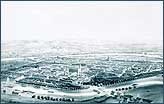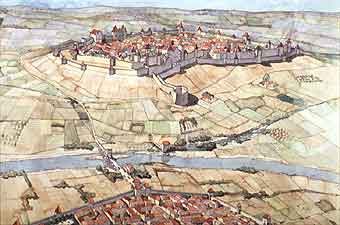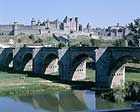 |
|
The city of Carcassonne
and the Saint-Louis bastide.
1462. Pen and gouache. | |
 |
|
Carcassonne.
Viewed from above the Midi Canal. Drawing by A. Guesdon.
Lithograph by Curvillier.
|
|
|
THE SAINT-LOUIS BASTIDE
XIIIth - XIVth Centuries
|
 |
| |
  fter the surrender of Raymond Trencavel II, Louis IX (the future
Saint Louis) gave the inhabitants of the old suburbs that had
been destroyed the right to settle on the right bank of the
Aude at the foot of the fortified city. The town, founded in
1248, was laid out on a 1,000 m. orthogonal plan and surrounded
by walls. The square where fairs and markets were held was its
social and economic centre while the churches of Saint-Michel
et Saint-Vincent were the spiritual heart of the two parishes.
The town prospered - it became one of the biggest centres of
the drapery industry in Languedoc - encouraging the mendicant
Cordelier, Jacobine, Carmelite and Augustinian Hermit orders
to settle outside its walls. The Plague, famine and the Hundred
Years War combined to put an end to the town's ambitions. In
spite of the resistance put up by the people of Carcasssonne
the Prince of Gaul (the Black Prince) had no difficulty in subduing,
burning and pillaging it in November 1355. It was quickly rebuilt
with particular care being taken to construct, although it covered
a smaller area, a rampart with circular towers which was protected
by a wide ditch. From then on a bridge (the Old Bridge) spanned
the Aude, linking the Lower Town and the Upper Town (la Ville
Basse and la Ville Haute).
fter the surrender of Raymond Trencavel II, Louis IX (the future
Saint Louis) gave the inhabitants of the old suburbs that had
been destroyed the right to settle on the right bank of the
Aude at the foot of the fortified city. The town, founded in
1248, was laid out on a 1,000 m. orthogonal plan and surrounded
by walls. The square where fairs and markets were held was its
social and economic centre while the churches of Saint-Michel
et Saint-Vincent were the spiritual heart of the two parishes.
The town prospered - it became one of the biggest centres of
the drapery industry in Languedoc - encouraging the mendicant
Cordelier, Jacobine, Carmelite and Augustinian Hermit orders
to settle outside its walls. The Plague, famine and the Hundred
Years War combined to put an end to the town's ambitions. In
spite of the resistance put up by the people of Carcasssonne
the Prince of Gaul (the Black Prince) had no difficulty in subduing,
burning and pillaging it in November 1355. It was quickly rebuilt
with particular care being taken to construct, although it covered
a smaller area, a rampart with circular towers which was protected
by a wide ditch. From then on a bridge (the Old Bridge) spanned
the Aude, linking the Lower Town and the Upper Town (la Ville
Basse and la Ville Haute).
|

|
|

|
| |
This reconstruction is based on the 1462 drawing which has been interpreted and completed in the light of present historical and archaeological knowledge. The city is seen from the north west. |
| |
The Old Bridge.
|
| |
 |
|




 fter the surrender of Raymond Trencavel II, Louis IX (the future
Saint Louis) gave the inhabitants of the old suburbs that had
been destroyed the right to settle on the right bank of the
Aude at the foot of the fortified city. The town, founded in
1248, was laid out on a 1,000 m. orthogonal plan and surrounded
by walls. The square where fairs and markets were held was its
social and economic centre while the churches of Saint-Michel
et Saint-Vincent were the spiritual heart of the two parishes.
The town prospered - it became one of the biggest centres of
the drapery industry in Languedoc - encouraging the mendicant
Cordelier, Jacobine, Carmelite and Augustinian Hermit orders
to settle outside its walls. The Plague, famine and the Hundred
Years War combined to put an end to the town's ambitions. In
spite of the resistance put up by the people of Carcasssonne
the Prince of Gaul (the Black Prince) had no difficulty in subduing,
burning and pillaging it in November 1355. It was quickly rebuilt
with particular care being taken to construct, although it covered
a smaller area, a rampart with circular towers which was protected
by a wide ditch. From then on a bridge (the Old Bridge) spanned
the Aude, linking the Lower Town and the Upper Town (la Ville
Basse and la Ville Haute).
fter the surrender of Raymond Trencavel II, Louis IX (the future
Saint Louis) gave the inhabitants of the old suburbs that had
been destroyed the right to settle on the right bank of the
Aude at the foot of the fortified city. The town, founded in
1248, was laid out on a 1,000 m. orthogonal plan and surrounded
by walls. The square where fairs and markets were held was its
social and economic centre while the churches of Saint-Michel
et Saint-Vincent were the spiritual heart of the two parishes.
The town prospered - it became one of the biggest centres of
the drapery industry in Languedoc - encouraging the mendicant
Cordelier, Jacobine, Carmelite and Augustinian Hermit orders
to settle outside its walls. The Plague, famine and the Hundred
Years War combined to put an end to the town's ambitions. In
spite of the resistance put up by the people of Carcasssonne
the Prince of Gaul (the Black Prince) had no difficulty in subduing,
burning and pillaging it in November 1355. It was quickly rebuilt
with particular care being taken to construct, although it covered
a smaller area, a rampart with circular towers which was protected
by a wide ditch. From then on a bridge (the Old Bridge) spanned
the Aude, linking the Lower Town and the Upper Town (la Ville
Basse and la Ville Haute).
